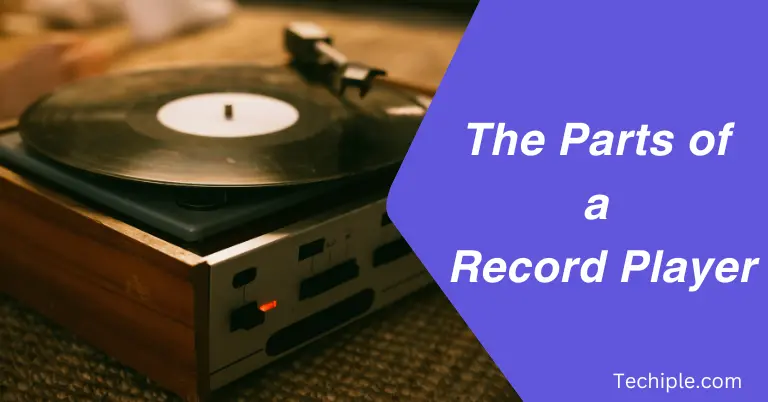10 Parts of a Record Player – A Comprehensive Exploration of Components

If you are new to a record player, you must know about the parts of a record player. A record player is a timeless piece of technology that continues to captivate audiophiles and music enthusiasts alike. With the resurgence of vinyl records, many are rediscovering the rich analog sound that streaming music and CDs can’t quite replicate.
The turntable, a key part of a record player, plays an essential role in sound manipulation. Proper maintenance and care of its parts, from the stylus to the motor, are crucial for optimal performance.
For those passionate about the analog experience, understanding the parts of a record player is essential. Whether you’re using it for listening to Bob Marley’s legacy through House of Marley products or exploring other vinyl records, knowing each component helps you maintain your equipment.
If you ever encounter a warped record, which can affect sound quality, you should explore solutions to restore your vinyl to its best condition. Proper care and attention to your records will ensure they continue to deliver that warm, rich sound that only vinyl can offer.
This guide will walk you through the critical parts and how they work together to produce beautiful music. So lets discuss each part of a record player.
The Parts of a Record Player

Here are the major components of a record player, each playing a pivotal role in crafting perfect audio from your records
1. Plinth
So the first part in our guide is the plinth, a crucial component of any turntable setup. The plinth serves as the foundation that supports the entire system, ensuring stable playback and a smooth experience when using a vinyl record player. It provides a sturdy surface for the turntable, and its flat surface is essential for minimizing vibrations during operation.
A high-quality plinth is designed to absorb and reduce unwanted movements, allowing your turntables to perform at their best. Many modern plinths are made from sustainable materials like sustainably-sourced bamboo or recyclable aluminum, reflecting brands like House of Marley that emphasize environmental stewardship.
Whether square or rectangular, the plinth ensures your turntable remains perfectly aligned and free from distortions. Its robust construction guarantees an even surface, which is vital for the accuracy of every rotation and the longevity of your vinyl collection.
2. Platter
The platter is a vital component of any record player, serving as the spinning surface that holds the vinyl record in place during playback. Designed to be both moveable and circular, the platter ensures that the record spins at the correct speed for optimal sound quality. Made from high-quality materials like metal, the platter is often paired with a turntable mat, which provides a soft material surface that reduces vibration noise and enhances sound clarity.
For brands like House of Marley, the use of eco-friendly materials in the platter’s construction not only boosts durability but also adds a touch of style to the record player. The precision of the platter’s movement is crucial, as it minimizes unwanted vibrations and maximizes the richness of the vinyl’s playback, delivering a true, immersive listening experience. The plinth, or base of the player, supports the platter and helps isolate it from external disturbances, ensuring smooth rotation and uninterrupted sound quality.
3. Motor
To spin the record player smoothly, the motor plays a crucial role in driving the platter with precision. House of Marley, known for its high-quality audio products, ensures that the motor provides optimal torque and power, enabling the turntable to maintain consistent speed.
There are two main types of motor systems in record players: direct-drive and belt-drive. The direct-drive system offers a quicker response time and higher torque, while the belt-drive system, using a rubber belt, reduces vibrations, providing a quieter operation and enhancing sound clarity. Both types have their advantages, but choosing the right one depends on the listener’s preference for stability and minimal noise during playback.
4. The Needle
Needles, also known as styluses, are an essential component of a vinyl record player. These small, precise tools feature diamond tips that trace the grooves on the vinyl platter. As the needle moves along the grooves, it picks up subtle vibrations that are processed by the cartridge, ultimately producing sound.
The accuracy of the needle’s tracing ensures that the music or audio is faithfully reproduced. Given its crucial role in sound quality, the needle is considered an important part of the record player, making it indispensable for enjoying vinyl records.
5. Speed Selector
The speed selector on a turntable allows users to effortlessly switch between different rotation speeds, such as 33 1/3 RPM, 45 RPM, and 78 RPM, ensuring optimal playback for various vinyl records. This user-friendly switch provides accurate pitch control, allowing the intended tempo to be heard precisely as it should. With a simple adjustment, the speed selector guarantees that each record is played at the correct rotations per minute, enhancing the overall listening experience.
6. Tonearm
The tonearm is a long, essential component of any turntable, contributing significantly to the audio experience. It holds the cartridge, which houses the stylus or needle, responsible for tracing the grooves of a spinning record on the platter. The tonearm’s tracking accuracy is vital, as it ensures the stylus applies the correct pressure and maintains the right angle to capture every detail of the music. When paired with high-quality brands like House of Marley, the tonearm enhances overall sound performance, offering a rich and precise listening experience.
7. Cartridge
The Cartridge is used to convert the mechanical vibrations from the record grooves into electrical signals. This process begins when the stylus, or needle, moves through the grooves of the record. The tonearm holds the cartridge in place, ensuring accurate tracking of the grooves.
These vibrations are then transformed into electrical signals, which are sent to an amplifier. The amplifier boosts these signals, sending them to the speakers, where they are heard as sound. The cartridge plays a crucial role in delivering high-quality audio output, bringing music to life with every turn of the turntable. Its precision and reliability reflect the brand’s promise of clear, vibrant sound.
8. Counterweight
The counterweight is used in record players to ensure the tonearm maintains proper balance and applies the correct tracking force. By adding downward pressure, it helps the stylus maintain optimal contact with the record surface, preventing excessive wear on both the vinyl records and the stylus.
An adjustable weight allows for easy-to-adjust fine-tuning, ensuring the right amount of pressure is applied for the best audio performance. This gentle touch enhances the overall listening experience, preserving the quality of the records while achieving exceptional sound clarity.
9. Anti-Skate
The anti-skate mechanism is an essential feature in vinyl record players, particularly in high-quality models like House of Marley turntables. It ensures the tonearm remains properly aligned and prevents drifting, which can cause audio distortion during playback. This mechanism helps maintain the stylus’ position at the center of the record, allowing for a balanced listening experience.
With the right anti-skate features, you protect your vinyl collection, ensuring longevity for both your records and turntable. Proper anti-skate adjustment promotes consistent sound quality and preserves the integrity of your record collection over time.
10. Preamp
Preamps play a vital role in an audio setup, enhancing the overall sound quality and ensuring a smooth connection between turntables and the speaker system. A good preamp, like the ones offered by House of Marley, ensures that the signal from the turntable’s cartridge is amplified to an optimal level for clear, room-filling sound.
Whether you’re using an external device or relying on built-in preamps, the phono preamp or preamplifier is an essential electronic component that maximizes the performance of your record player.
Outputs and Inputs
If you want to connect any external audio equipment to your vinyl record player, there are various input and output options available to enhance your listening experience. Modern record players, especially those with adaptable connectivity, offer both RCA and Bluetooth connections for easy integration with audio devices like speakers, amplifiers, or headphones.
Whether you’re using a wired setup or enjoying the convenience of wireless Bluetooth, these external connection points ensure seamless audio flow, bringing a rich sound experience. For instance, brands like House of Marley provide high-quality turntables that support multiple connectivity options, giving you flexibility in how you enjoy music from your record player parts.
The Speakers
Speakers can be built in or separate, like a preamp, depending on the setup and sound preferences. Record players with separate speakers often provide superior sound output, especially for serious listening. These systems may include higher-end features, such as built-in preamps, offering flexibility for customization.
The manual or setup guide can assist users in connecting the correct color-coded cables and sockets to ensure optimal performance. While built-in preamps offer convenience, separate preamps may be preferred by audiophiles for their ability to enhance sound quality. Despite the limitations of built-in models, the ability to customize setups ensures a personalized listening experience.
Belt or Direct Drive
The direct drive and belt drive are two types of turntables, each with its unique characteristics. A direct drive turntable features a motor directly connected to the platter, allowing for quicker starts and a more consistent speed. It minimizes vibration and noise interference, providing a crisper, cleaner sound for a superior listening experience.
On the other hand, a belt drive turntable uses a belt to connect the motor to the platter, which can help reduce motor noise and vibration, often resulting in a smoother sound. However, over time, the belt can wear out and may need to be replaced, especially with regular use.
Both systems can spin and play records effectively, but the setup and maintenance practices may differ. Belt drives are known to require periodic belt replacements, while direct drive systems tend to last longer without such concerns.
How To Use a Tonearm

To use a tonearm effectively, start by understanding its key components and how they impact vinyl playback. First, ensure that your tonearm is properly balanced. An unbalanced tonearm can cause tracking issues and lead to sound problems, including poor audio fidelity or even record damage.
Adjust the tracking weight according to the specifications to avoid excessive pressure on the needle, as this will ensure optimal needle placement and prevent unnecessary wear on your vinyl records.
When setting up a manual record player or semi-automatic turntable, take extra care to calibrate the tonearm mechanism, ensuring it moves smoothly across the record’s grooves. Audiophiles often emphasize the importance of fine-tuning the cue level to achieve accurate sound reproduction.
Even with automatic record players, it’s important to check the balance and the tracking weight regularly to maintain consistent record playback.
For precise tonearm setup, always refer to your turntable’s manual to avoid mistakes that could compromise your listening experience. Proper setup guarantees better audio equipment performance, enhancing both the clarity and depth of sound when playing vinyl records.
Conclusion About Turntable Parts
A record player is a masterpiece of logically connected parts that work harmoniously to deliver exceptional sound, captivating audiophiles and collectors alike. Each moving component, from the needle to the platter, plays a crucial role in bringing vinyl records to life.
Understanding the parts of a record player and how they work together can expand your appreciation and enhance your collection. By replacing worn-out parts thoughtfully, you ensure your catalog of records continues playing flawlessly, making every listening session a fulfilling experience.
For a deeper look at the history and cultural impact of vinyl records, check out this insightful article on The Rise, Fall, and Rebirth of Vinyl Records from Baylor University’s blog.




